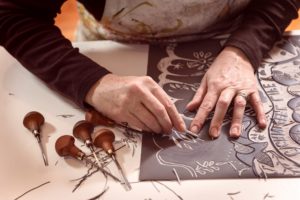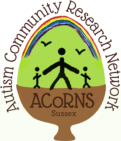At our final reading group of the academic year we visited the theme of our recent event “Autistic Voices: across the spectrum”. As ever, we had a great range of perspectives and a really thoughtful discussion. Our advance questions were:
- How can we try to ensure that voices from the whole autistic spectrum are included in research? Including those with and without learning disabilities and all types of communication – “ Their is huge gap in who we are collecting voices off: around 50% of autistic people have learning disabilities but 94% of reported research involves participants without learning disabilities”
- What good experiences have people had and what can be better across education, health and social care services to provide a space for autistic voice?
- How can social media, e.g., autistic bloggers, be used to empower autistic voice?
- Should we use the term voice – does this exclude non-verbal autistic people?
Need for diverse methods:
 We kicked off the session by discussing Marysia Szlenker’s Poem: The unseen struggles of autism & pathological demand avoidance at university. We found the poem really interesting: our members working in earlier stages of the education system praised how eye opening it was for them to learn about later stages of education. We shared how refreshing it is to see voice expressed in a different form. Effective use of different ways of expressing experiences give people an opportunity to explain things that they may not have been able to express in prose. A group member linked to the views of Tony Attwood, who is a great advocate of using any form that works well for the person, be that music, artwork or any other creative forms. Language might not always be the best way to gather views: one person mentioned ‘thinking outside the box’. This could be very effective in the annual review process. The current process doesn’t fit
We kicked off the session by discussing Marysia Szlenker’s Poem: The unseen struggles of autism & pathological demand avoidance at university. We found the poem really interesting: our members working in earlier stages of the education system praised how eye opening it was for them to learn about later stages of education. We shared how refreshing it is to see voice expressed in a different form. Effective use of different ways of expressing experiences give people an opportunity to explain things that they may not have been able to express in prose. A group member linked to the views of Tony Attwood, who is a great advocate of using any form that works well for the person, be that music, artwork or any other creative forms. Language might not always be the best way to gather views: one person mentioned ‘thinking outside the box’. This could be very effective in the annual review process. The current process doesn’t fit everyone and needs to be adapted to allow young people to express themselves in ways they feel comfortable. This led us to think about Mental Health Services for young people. One person said their service used phone calls when transferring a client from child to adult services but found replacing this with an email for response in 2 weeks had worked better for some neurodiverse clients. This however is still based around verbal responses. Using emojis can also help, but video methods, and illustrative methods are also gaining real traction, as shown by speakers Beth Sutton and Sarah Parsons at our online event.
everyone and needs to be adapted to allow young people to express themselves in ways they feel comfortable. This led us to think about Mental Health Services for young people. One person said their service used phone calls when transferring a client from child to adult services but found replacing this with an email for response in 2 weeks had worked better for some neurodiverse clients. This however is still based around verbal responses. Using emojis can also help, but video methods, and illustrative methods are also gaining real traction, as shown by speakers Beth Sutton and Sarah Parsons at our online event.
Need for support and representation of people from across the spectrum and the lifespan
Often there is a clear progression plan for young people from secondary to college etc, but not afterwards. People are becoming more aware of autism in schools, but we need to improve awareness that this doesn’t go away when they turn 18. Similarly, further and higher education need to make adaptations to support autistic students’ needs – but without forgetting the needs of autistic staff. There is also a lack of representation of voices from across the whole spectrum. Currently many voices are being missed from research. We thought about how and where participants are being recruited from and how we collect views. It doesn’t always need to be verbal. We should be creative and use inclusive methods, such as cards, visuals and tools like digital stories. It is essential that we include these unheard voices, especially when educating society about autism.
Strengths-Based Approaches:
We felt overwhelmingly a need to move away from deficit-based approaches and towards a strengths-based approach. We spoke about the difficulties in doing this – for example we focus on deficits right from diagnosis and highlighting deficits is currently essential to get a diagnosis as clinicians are really limited by DSM-5. As a group we loved the idea that a good report should enable the reader or listener to buy a suitable ‘birthday present’ for the subject of the report (Kluth, 2010). Sometimes gathering views can feel like a box-ticking exercise, but if done well and meaningfully it can be really powerful for the autistic person to know they have been listened to and changes have been made. One person shared just how important it is for a person to have a holistic view of themselves, including their strengths, which can often be harnessed to improve their life overall. Similarly, employers need to see what strengths an autistic person can bring. It would be great to provide young people with good autistic role model. At the same time, we wanted to recognise the difficulties people may face and understand what support would help. Every autistic person is different and will need different levels of support at different times.
approach. We spoke about the difficulties in doing this – for example we focus on deficits right from diagnosis and highlighting deficits is currently essential to get a diagnosis as clinicians are really limited by DSM-5. As a group we loved the idea that a good report should enable the reader or listener to buy a suitable ‘birthday present’ for the subject of the report (Kluth, 2010). Sometimes gathering views can feel like a box-ticking exercise, but if done well and meaningfully it can be really powerful for the autistic person to know they have been listened to and changes have been made. One person shared just how important it is for a person to have a holistic view of themselves, including their strengths, which can often be harnessed to improve their life overall. Similarly, employers need to see what strengths an autistic person can bring. It would be great to provide young people with good autistic role model. At the same time, we wanted to recognise the difficulties people may face and understand what support would help. Every autistic person is different and will need different levels of support at different times.
The power of social media in representing autistic voice:
 We moved on to speak about the impact of social media. Prominent bloggers have been at the forefront of driving neurodiversity as a concept and bringing awareness. How can we ensure that some of the great content creators can reach a wider range of people? Social media could be a really influential way to change attitudes more widely. One member cited a great example on TikTok of a neurodiverse person trying different sun creams and the sensory experiences that this brought. This seemed a really good way of showing that everyone’s experiences are different. A member linked it back to our previous group on belonging and highlighted how it can help improve belonging, knowing there are other people out there like you.
We moved on to speak about the impact of social media. Prominent bloggers have been at the forefront of driving neurodiversity as a concept and bringing awareness. How can we ensure that some of the great content creators can reach a wider range of people? Social media could be a really influential way to change attitudes more widely. One member cited a great example on TikTok of a neurodiverse person trying different sun creams and the sensory experiences that this brought. This seemed a really good way of showing that everyone’s experiences are different. A member linked it back to our previous group on belonging and highlighted how it can help improve belonging, knowing there are other people out there like you.
Towards the end of the meeting, we started to think more creatively about how social media could be used to gather views from young people in other settings, for example having a young person use TikTok to show what they like about school. These media are very inclusive, using text, video and audio.
Our reading group will take a pause over the summer break and recommence in September. Join our mailing list to hear all about the next meeting email: acorns@sussex.ac.uk
